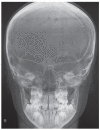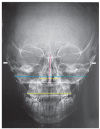Skeletal effects of RME in the transverse and vertical dimensions of the nasal cavity in mouth-breathing growing children
- PMID: 28902251
- PMCID: PMC5573012
- DOI: 10.1590/2177-6709.22.4.061-069.oar
Skeletal effects of RME in the transverse and vertical dimensions of the nasal cavity in mouth-breathing growing children
Abstract
Introduction:: Maxillary constriction is a dentoskeletal deformity characterized by discrepancy in maxilla/mandible relationship in the transverse plane, which may be associated with respiratory dysfunction.
Objective:: The objective of this study was to evaluate the skeletal effects of RME on maxillary and nasal transverse dimensions and compare the differences between males and females.
Methods:: Sixty-one mouth-breathers patients with skeletal maxillary constriction (35 males and 26 females, mean age 9.6 years) were included in the study. Posteroanterior (PA) radiographs were taken before expansion (T1) and 3 months after expansion (T2). Data obtained from the evaluation of T1 and T2 cephalograms were tested for normality with the Kolmogorov-Smirnov method. The Student's t-test was performed for each measurement to determine sex differences.
Results:: RME produced a significant increase in all linear measurements of maxillary and nasal transverse dimensions.
Conclusions:: No significant differences were associated regarding sex. The RME produced significant width increases in the maxilla and nasal cavity, which are important for treatment stability, improving respiratory function and craniofacial development.
Introdução:: a constrição maxilar é uma alteração dentoesquelética relacionada à diminuição transversal da arcada superior, que pode correlacionar-se com problemas respiratórios. O tratamento nos pacientes em crescimento inclui a expansão rápida da maxila (ERM). A correção precoce resulta em maiores alterações esqueléticas e estabilidade dos resultados, podendo evitar desvios de crescimento facial.
Objetivo:: avaliar comparativamente, por meio de telerradiografias posteroanteriores (PA), as alterações dimensionais da cavidade nasal pré- e pós-ERM em pacientes respiradores bucais dos sexos masculino e feminino.
Métodos:: realizou-se o estudo de medidas lineares em telerradiografias PA pré- e pós-ERM de uma amostra composta por 61 pacientes (35 do sexo masculino e 26 do feminino), com média de idade de 9,6 anos. Todos os pacientes eram respiradores bucais com constrição maxilar esquelética, e foram tomadas radiografias PA pré- e pós-ERM (3 meses). Os dados obtidos foram avaliados nos tempos T1 e T2 a normalidade dos dados foi confirmada por meio do teste de Kolmogorov-Smirnov. O teste t de Student foi aplicado para cada mensuração, para determinar diferenças entre os sexos.
Resultados:: a ERM promoveu aumento significativo em todas as medidas lineares maxilares e das dimensões da cavidade nasal.
Conclusão:: nenhuma diferença significativa foi associada ao sexo. A ERM produziu aumentos significativos na largura maxilar e volume da cavidade nasal, que são importantes na estabilidade do tratamento Nos pacientes em crescimento e respiradores bucais com constrição maxilar esquelética da maxila, a ERM promoveu aumento do volume da cavidade nasal que melhorou o fluxo aéreo e possibilitou reconduzir o crescimento facial. As alterações transversais não foram significativas quando relacionadas ao sexo.
Figures
References
-
- Magnusson A, Bjerklin K, Nilsson P, Jönsson F, Marcusson A. Nasal cavity size, airway resistance, and subjective sensation after surgically assisted rapid maxillary expansion a prospective longitudinal study. Am J Orthod Dentofacial Orthop. 2011;140(5):641–651. - PubMed
-
- El H, Palomo JM. Airway volume for different dentofacial skeletal patterns. Am J Orthod Dentofacial Orthop. 2011;139(6):e511–e521. - PubMed
-
- Cappellette M, Jr, Beaini TL. A tomografia computadorizada no diagnóstico e análise de pacientes submetidos a disjunção maxilar - revisão de literatura e apresentação de caso clínico. Sci Pract. 2014;7(27):134–140.
-
- McNamara JA. Influence of respiratory pattern on craniofacial growth. Angle Orthod. 1981;51(4):269–300. - PubMed
-
- Snodell SF, Nanda RS, Currier GF. A longitudinal cephalometric study of transverse and vertical craniofacial growth. Am J Orthod Dentofacial Orthop. 1993;104(5):471–483. - PubMed
MeSH terms
LinkOut - more resources
Full Text Sources
Other Literature Sources





